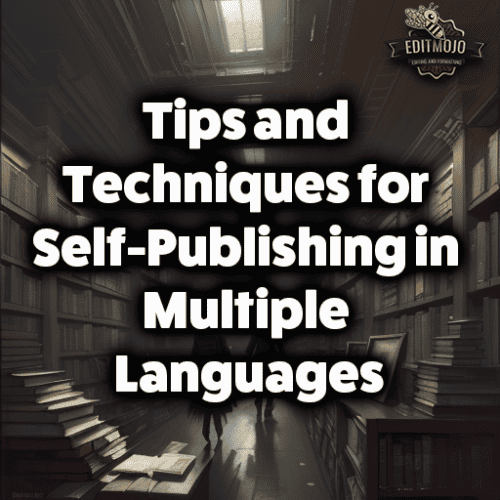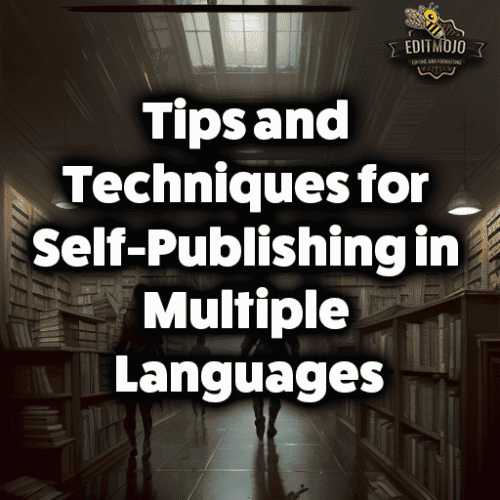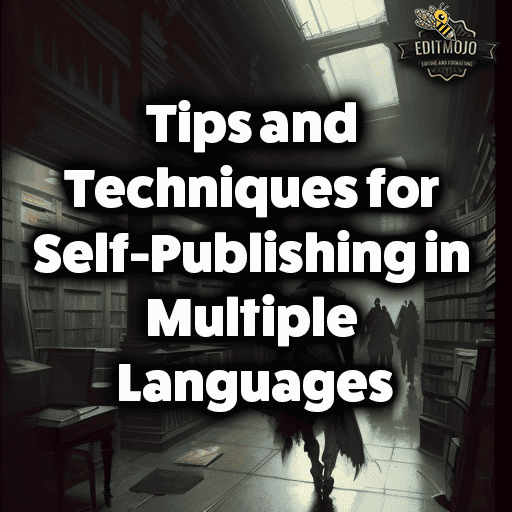Tips and Techniques for Self-Publishing in Multiple Languages
Tips and Techniques for Self-Publishing in Multiple Languages. Stepping into the world of self-publishing can feel like embarking on a thrilling journey filled with opportunities, challenges, and remarkable rewards. Even more adventurous is publishing in multiple languages. As authors embrace the globalized era, publishing across language barriers has transformed from being a bold endeavor to an essential strategy. Let’s embark on an in-depth exploration of this fascinating topic.
Key Takeaways Table
| Aspect | Key Takeaway |
|---|---|
| Value of Multilingual Publishing | Reaching a wider audience, fostering cultural exchange, gaining a competitive advantage. |
| Planning and Preparation | Understanding target markets, ensuring cultural adaptation and localization, choosing the right publishing format. |
| Translation Process | Prioritizing professional translation over machine translation, handling language-specific nuances, importance of proofreading. |
| Cost Management | Understanding potential costs, balancing quality and budget, exploring crowdfunding and grants. |
| Self-Publishing Platforms | Researching platform options like Amazon KDP, Smashwords, Lulu, and their terms of service, royalties, and contracts. |
| Marketing | Localization of marketing strategies, leveraging social media, and collaborating with local influencers. |
| Legal Considerations | Understanding international copyright laws and managing distribution rights. |
Understanding the Value of Multilingual Self-Publishing
We live in an increasingly connected world, with a rich diversity of languages and cultures. Publishing in multiple languages extends your ideas, stories, and knowledge beyond the limitations of language boundaries.

Wider Audience and Market
With every additional language you publish in, you gain access to a whole new pool of readers. Spanish, for instance, is the second most spoken language worldwide with over 460 million native speakers ^1^. Translating your work into Spanish could make your book accessible to this vast audience.
Cultural Exchange and Understanding
Publishing in multiple languages isn’t just about expanding your reader base. It’s a powerful tool for fostering cultural exchange. As renowned author Haruki Murakami once said, “Literature is a place where we can make each other feel less alone.” In this context, multilingual publishing forms a bridge, connecting diverse cultures through the universal language of storytelling.
Competitive Advantage
In the publishing world, multilingual authors have an edge. Their ability to cater to diverse readerships allows them to stand out in the crowded marketplace.
Pre-Publication Steps: Planning and Preparation
A well-planned journey is always more enjoyable, and the same goes for multilingual self-publishing.
Determining your Target Languages and Markets
Understanding your potential reader demographics is crucial. Research, analyze, and study successful multilingual authors in your genre. Tools like Google Trends and Keyword Planner can offer valuable insights into your target market’s preferences.
Cultural Adaptation and Localization
It’s not enough to translate the words; one must also translate the culture^2^. This involves making your work culturally relevant to your target audience. For instance, if a key scene in your book is centered around a Christmas dinner and you’re translating into a language spoken predominantly in a non-Christian country, you might want to consider adapting this scene to fit the local culture better.

Deciding on the Publishing Format
Whether it’s eBooks, printed books, or audiobooks, each format comes with its own set of considerations. Printed books might create a tactile experience, but eBooks provide ease of distribution, especially for a global audience.
The Translation Process: Navigating Challenges
Translation is much more than swapping words between languages. It’s an art of capturing the spirit of the original text and recreating it in a different linguistic landscape.
Professional vs. Machine Translation
While machine translation tools like Google Translate have made significant progress, they can’t match a professional human translator’s finesse, especially for literary works.
Hiring a Professional Translator
When hiring a translator, look for their expertise in your book’s genre, fluency in source and target languages, and cultural knowledge. Websites like ProZ and TranslatorsCafé are excellent starting points to find a suitable translator^3^.
Language-specific Nuances and Idioms
Every language has unique nuances and idioms that can be challenging to translate. For example, an English idiom like “raining cats and dogs” would make no sense if translated literally into another language. In such cases, the translator must find an equivalent idiom in the target language.
Understanding the Costs of Multilingual Self-Publishing
Multilingual self-publishing comes with costs, but with smart planning, these can be well-managed.
Potential Costs Involved
Professional translation services, proofreading, cover designing for different versions, and marketing all involve costs. It’s essential to budget for these while planning your multilingual publication.

Balancing Quality with Budget
Investing in quality translations and proofreading is vital, but there are ways to balance this with your budget. For instance, consider collaboration with translation students who are looking for projects to showcase in their portfolio.
Crowdfunding and Grants
Platforms like Kickstarter and GoFundMe provide opportunities to crowdfund your self-publishing project^4^. Some countries also offer grants and financial support for translation and publication of literary works.
Platforms for Multilingual Self-Publishing
Numerous platforms facilitate self-publishing in multiple languages. Some popular ones include Amazon Kindle Direct Publishing (KDP), Smashwords, and Lulu^5^. These platforms vary in their terms of service, royalty structures, and market reach, so be sure to do your research and choose the one that best suits your needs.
Marketing Your Multilingual Publication
Publishing your book is just the beginning. Ensuring it reaches the right audience requires effective marketing tailored to each language and culture.
Tailoring Your Marketing Strategies
Marketing strategies should be localized to resonate with each target audience. The social media channels popular in one country might not be the same in another. Understanding these nuances can significantly enhance your marketing efforts.
Collaborating with Local Influencers
Engaging with local influencers, book bloggers, and reviewers can help promote your book to the right audience. You can also consider virtual book tours or readings to connect directly with your readers.
Legal Considerations in Multilingual Self-Publishing
Navigating the legal landscape of international publishing can be daunting, but it’s a crucial part of the process.
Understanding Copyright Laws
Copyright laws vary from country to country^6^. Understanding these variations is key to protecting your work.
International Distribution Rights
Managing international distribution rights can be complex, especially if you’re publishing through different platforms for different languages. Ensure you fully understand the terms before agreeing to any contracts.
Case Studies of Successful Multilingual Self-Publishing
Studying success stories can provide inspiration and practical guidance. Authors like Hugh Howey and Amanda Hocking have successfully self-published their works in multiple languages and gained international recognition^7^.
Conclusion (Tips and Techniques for Self-Publishing in Multiple Languages)
Multilingual self-publishing may be a complex process, but the rewards it brings — reaching a global audience, sharing ideas across cultures, and broadening your horizons as a writer — are immeasurable. So, embrace the challenge, and remember, the world is waiting to hear your story.
Additional Resources (Tips and Techniques for Self-Publishing in Multiple Languages)
For those ready to embark on their multilingual self-publishing journey, here are some additional resources to explore:
- Self-Publishing Tools: Reedsy^8^, Canva^9^
- Professional Associations: American Translators Association^10^, Society of Authors^11^
- Further Reading: “The Business of Being a Writer” by Jane Friedman^12^, “Self-Publisher’s Legal Handbook” by Helen Sedwick^13^
Remember, the journey of multilingual self-publishing is a marathon, not a sprint. Take one step at a time, and enjoy the ride.
Top Five Questions and Answers
| Questions | Answers |
|---|---|
| Why should I consider multilingual self-publishing? | Multilingual publishing allows you to reach a wider audience, foster cultural exchange, and gain a competitive advantage in the global literary landscape. |
| What are the major costs involved in multilingual self-publishing? | Major costs include professional translation, proofreading, cover design for different versions, and marketing expenses. |
| What is the role of cultural adaptation in multilingual publishing? | Cultural adaptation ensures that your work is relevant and respectful to the target culture, enhancing reader engagement and acceptance. |
| Which platforms can I use for multilingual self-publishing? | Amazon KDP, Smashwords, and Lulu are popular platforms that support multilingual self-publishing. |
| What legal considerations should I keep in mind? | Understanding the copyright laws of different countries and managing international distribution rights are crucial legal considerations in multilingual self-publishing. |
Top Seven Resources and Further Reading
| Resource | Link |
|---|---|
| Reedsy: Self-Publishing Tool | Reedsy |
| Canva: Design Tool | Canva |
| American Translators Association: Professional Association | ATA |
| Society of Authors: Professional Association | Society of Authors |
| “The Business of Being a Writer” by Jane Friedman | Book Link |
| “Self-Publisher’s Legal Handbook” by Helen Sedwick | Book Link |
| TranslatorsCafé: Translator’s Platform | TranslatorsCafé |
